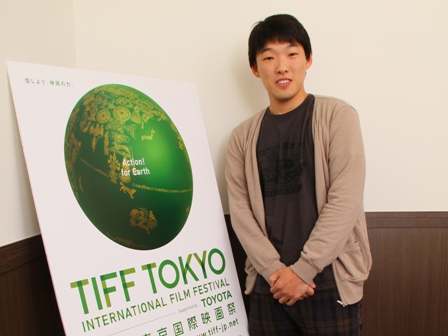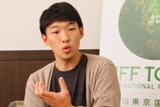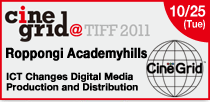Japanese Eyes “TOKYO DRIFTER”
interview with Tetsuaki Matsue (Director)

In “Tokyo Drifter,” director Tetsuaki Matsue follows singer Kenta Maeno over a rainy night throughout Tokyo as he sings a set of songs reflecting on life, love and most of all, Tokyo itself. The haunting images of a darkened post-Tohoku disaster Tokyo serve as the backdrop Tetsuaki’s meditation on Japan in 2011. In one scene, Maeno-san zooms down a busy street on his motorcycle singing AKB 48’s hit “Heavy Rotation.”
— So, how do feel about AKB 48?
Tesuaki Matsue: I’m not that much of an enthusiastic fan of group. But like most pop songs, wherever you are you hear the song.
— I think “Heavy Rotation” is a great song.
Matsue: Me as well.

— Were you thinking about “Tokyo Drifter” before the earthquake and the tsunami or is this film your and Maeno-san’s reaction to what happened?
Matsue: Neither. I wasn’t thinking about it before. I wasn’t even thinking about making this into a film even after. I was in Korea when the earthquake happened and came back to Japan on the 23rd of March. So I had heard about what went on and had some people asking, “Why aren’t you there making a documentary about what’s happening?” I also knew that my friend, another director, was in Fukushima making a documentary. I also had a producer contacting me, requesting me to go to the stricken area to film, but I wasn’t thinking about being involved in making a film about that, at all, at that time. And I told the producer clearly, that I can’t make a film under this kind of situation. When I arrived at Haneda airport, I was surprised that it was so dark. I live in Nakano, so I passed through Shinjuku to go back home and I realized that it was dark in those areas as well. Everyone was saying, of course, that it was the Tohoku area that was stricken by the earthquake and that there were many victims, but I felt at that time that Tokyo was also a victim of the earthquake. That’s what I thought at that time. But I thought Tokyo was rather appealing under that situation because I had been to various international film festivals and saw that in Germany at 8 o’clock all the stores close. The stores close on Sundays and there is no lighting on the displays. So, at night, it’s natural that there’re no lights. I mean, it’s dark – and that was one of the appealing points about these countries. So from that perspective, I thought that although it’s under this situation, Tokyo looked rather appealing to me. The turning point of me wanting to make a film was that on April 10th in Koenji there were protesters demonstrating about the nuclear disaster. I was there from the beginning to the end. There were all these people protesting. On the other hand there were people at that same time saying, “If you’re going to protest, why didn’t you protest when TEPCO built the nuclear power plants?” I thought that in current day Japan that unless people really stood up and voiced their opinions, nothing was going to change in Japan. That’s what I strongly felt. So on that day, I, as a filmmaker and as an individual, I felt that I could feel something in common with what the protesters were talking about. I went home and it was the same day as the election and Shintaro Ishihara was elected right away. It was on the news that he’d be the mayor again of Tokyo and the newscasters were saying, “We need to have him build a strong Tokyo.” They were saying that they were predicting a big earthquake would hit Japan or the Tokyo area within 30 years with a 70 or 80 percent possibility. Just a while ago they were saying that this is a catastrophe that happens once in 1000 years. And I was thinking that if I eventually had children as well I thought – a strong Tokyo? Is this what people are expecting? I mean there are different values. And I felt it was very strange that somebody would be asking for the mayor to make a strong Tokyo – that Tokyo needs to be much stronger. On the other hand, I thought, it was OK. You could be weak. You didn’t have to be strong if you’ve got different values. I thought that Tokyo the way it was under this situation was something I liked. I thought it was something I would want to make into a movie, so I called my crew right away and told them, “Hey, I’m interested in making a film.” That was on April 10 – from the demonstration that started in Koenji.
— So then, that was April 10. On May 28 you made the film. How did you and Maeno-san collaborate in developing the film? I know you’ve had an old relationship with “Live Tape,” but how did you develop this idea?
Matsue: I didn’t want to pursue perfection with this film. And with Ryuto Kondo, who had just filmed “My Back Page” – he has a lot of talent and is very skilled – but rather than try to pursue perfection, I suggested we go back to the origin of making films and start with a handi-cam. And take the film from that perspective, rather than trying to target perfection with the film itself. And so we shot it with auto-focus and was like, everything you see in the film – whether it’s out of focus, noisy and everything, I thought it was the reflection of everyone during those times. People were scared of the rain, the radiation. And I thought, filming everything naturally sort of reflected everyone’s feelings at that time. So, we went ahead and shot with autofocus. And when I was in Korea, I was looking at youtube. There were actually a lot of amateurs who were in the stricken area, shooting the tsunami coming in. They’re amateurs of course. I thought that is what I had to do in order to reflect the current situation. So, in other words, it’s like trying to minimize the means of making the film. With the scenes that I saw on Youtube, I don’t think it’s correct to say that they influenced me a lot – because people were in a very panic-stricken situation and they were doing what they thought would be the best to do – but that had an impact on me. If you really went there as a documentary film crew you would be asking people to help you. You would be using lights, electricity. In that situation it was very difficult to get electricity. When you’re making a full documentary, you’re causing a lot of problems for people that are around you. I didn’t want to do that. I wanted to minimize the means and get as much as possible in a natural state.

— I thought of youtube also when I saw your film. But the sound was very good. And there’s an interesting counterpoint between images that are out of focus, the rain, the fog and then very good sound. The film takes place over one night and it’s interesting as documentary vs. performance art. So from say, 10 o’clock until the morning, you’re going to make this movie, no matter what. Can you comment about this aesthetic, this idea of this type of documentary?
Matsue: As for sound, you have to think about… oh, this is going to be screened at a theater. So, the audience has to be able to sit through the film. The sound can’t be something uncomfortable. In terms of being out of focus or not very clear, that didn’t really matter, but sound is very important to me, so that’s what I’m focusing on right now. If I had money, if I had time, that’s what I would focus on – is to trying to get the sound perfect. In terms of visuals I think the audience has a capacity – they accept different levels of visuals, because we have youtube and all kinds of different media we see different levels of perfection. But in terms of sound, the audience cannot come to terms with something that still uncomfortable to hear, so sound is very important to me. So I went back after shooting those several hours. I had Maeno-san sing again, so I could pick up his voice more clearly. As well in the beginning where you hear the sound at Studio Alta. On of my friends had my camera on the day the earthquake happened and he was out actually picking up the visuals and the sound. But I thought the visuals had too much impact, so I told my sound person to just make sure we could use the sound of this footage. I really don’t have a lot of influence from other documentary directors, but “Gummo,” by Harmony Korine and “The Dark Night” were two films I watched over and over again before making this film. I wanted to get a sense of how you shoot reality and I thought these were good influences. “Gummo,” yeah, for after the typhoon and how people survive. I like the style of how it captures people. Maeno-san is one of my heroes. Like in the last scene of “The Dark Night,” the Joker is the town of Tokyo. Maeno-san is on his bike, driving away. Maeno-san himself is like Batman. I just wanted to use that, but I didn’t tell my crew about it. If I told Maeno-san about it, Batman would be on his mind too much. I you reference different films to the crew, it’s not good. You probably wouldn’t think of “The Dark Night” or “Gummo” after watching my film.
— So you didn’t want Maeno-san to think of Batman, but with the title of the film, “TOKYO DRIFTER,” did you think of Joe Shishido?
Matsue: “Tokyo Drifter” was a series I was writing in a magazine, so that’s where the title came from. I liked the title so much I wanted to use it somewhere. So, when I decided to make a film, I said, “Oh, I want to use this as the title.” It was the editor in Seijun Suzuki’s film that decided to use “Tokyo Drifter.” It had nothing to do with my idea, but mine goes back to [photographer] Shinya Fujiwara’s “Tokyo hyo-ryu” – also meaning “Tokyo Drifter.” Maybe foreigners always think of Seijun Suzuki when you hear the word Tokyo Drifter, but people here automatically think of the comedy, “The Drifters.”
— Were the songs written for the movie or songs written over the years?
Matsue: These were all songs Maeno-san composed before the earthquake, but the last song, “New Morning” is something that he was singing before the earthquake – last year actually. After the earthquake the song itself had a different meaning for me. While I was in Korea, I was listening to this song. It was during a time when you could hear people being very afraid of the radiation. So, it started to take a different meaning. From the very beginning I asked Maeno-san, “I want you to sing that song at the end of this film” because I thought it had an impact. There were several songs that Maeno-san did compose after the earthquake – Tokyo 2011, for example… the Coca Cola song. I wrote the words to “Tokyo Drifter.” When I was location hunting, Maeno-san said “You have to write the lyrics, because it will also give you an idea of what the film is about.” And that’s why I was forced to write the lyrics of the song “Tokyo Drifter.” And reading the lyrics, Maeno-san more deeply understood what the film was about.
— The locations, some are well known. Others are convenience stores and generic locations. Can you tell me about why you chose these different places?
Matsue: Some of my crew that came from outside of Tokyo. For them, Tokyo Tower was symbolic of Tokyo. I went to Roppongi as well as Ginza. In trying to capture the darkness of Tokyo, it didn’t mean going some place and filming it because it was dark. That wasn’t what I wanted to do. So I thought of convenience stores, like 7-11 where usually the neon lights are very bright, but they had to turn off quite a lot of the lights… that I thought had a lot of impact. I was talking about it with the crew and decided we wanted to shoot places that normally would be very light, but because of this situation they had to turn the lights down. That’s how we came up with this idea. In order to capture the darkness of Tokyo as it was at that time was not to choose places that were dark in the beginning, but to choose places that would have normally been more illuminated. We had to find a route that we could shoot in one night. Shinjuku and Shibuya were good – and also Meidaimae, where Maeno-san used to live before. So that’s how we chose the locations.

— And the final location, on the river?
Matsue: So that was in Kawaguchi City in Saitama, across the river. I wanted to get a shot of Tokyo. That’s why I went to Kawaguchi. I thought if I went out of Tokyo I could capture the whole city. And to me, rivers play a very important role in films. When you see a flowing river you can imagine what’s outside that frame. So I thought it was very important. Rivers play a big role in expanding the imagination of the audience. The ocean is too big, but with the river you can image there are people living outside this frame along the banks of the river. So that’s why I thought the river was very important.
— The film is like a love letter to Tokyo. And interesting and positive response to the tragedy of 3.11. Anything more to say about that?
Matsue: The Tokyo now and the Tokyo then is different. In May everyone was on edge. They didn’t know what was happening. I prefer Tokyo then in May, rather than the Tokyo we’re in now.
Interviewed by Nicholas Vroman (Film writer)
TOKYO DRIFTER












